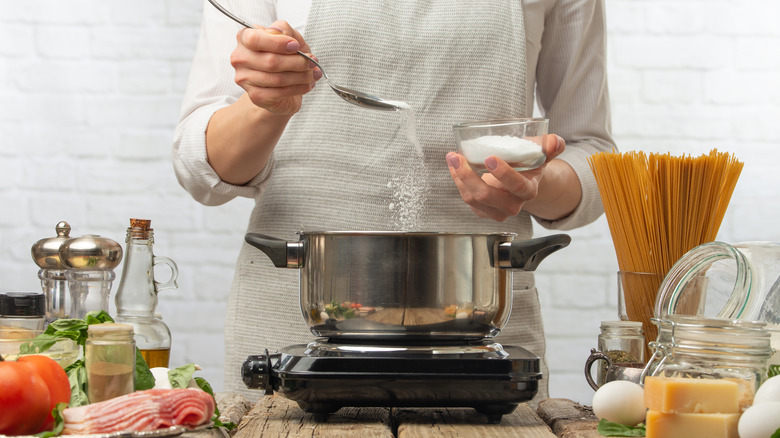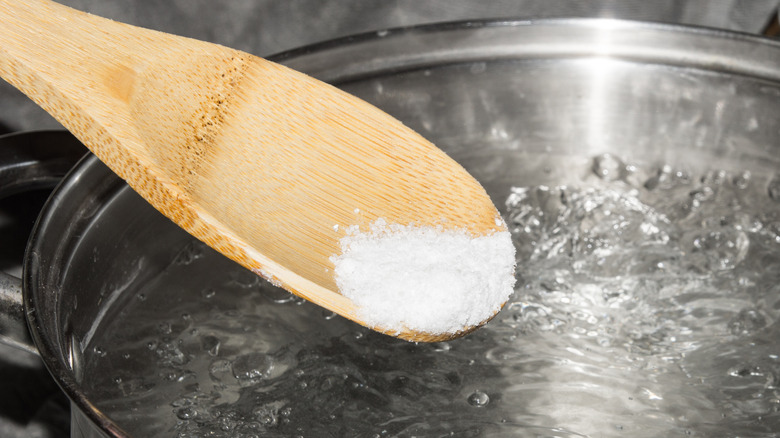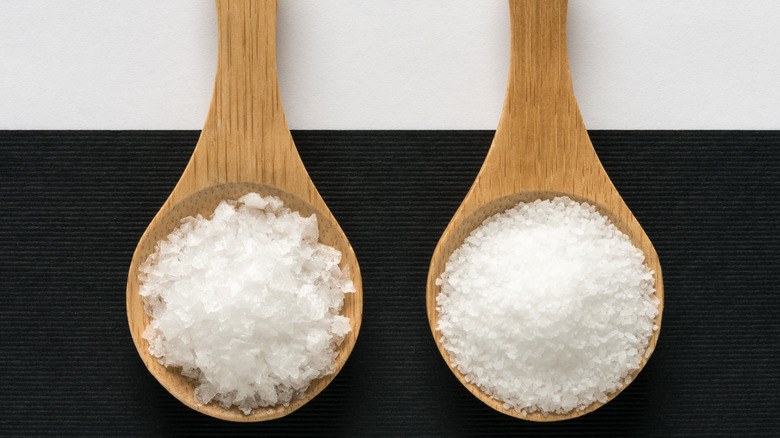When To Add Salt To Pasta Water For Flawless Results
All Italian cooks say it's necessary to properly salt pasta water, but with just how much salt and when to do it is not always clear. Nonnas have said that pasta water should "taste like the sea," which is rather vague and sounds like it could be an alarming amount of sodium, but more may be better since the only time to really flavor noodles is when they cook.
Equally important is knowing when to salt the water. For the best results, you'll want to wait until after it comes to a boil; then once it returns to boiling, add the pasta. It may seem trivial, but salting too early can affect the end result — and your pot.
Since salt does not dissolve well in cold liquids, it will fall to the bottom of the pot until the water boils. And, since different types dissolve at different rates, some varieties (like sea salt) will sit there longer, which provides more time for the sodium chloride to react with the stainless steel, causing the surface to 'pit.'
While this doesn't ruin the pot, 'pitting' corrodes the surface, creating dull-looking spots that grow over time. These flaws are not reversible but are preventable if you wait until the water comes to a rolling boil before adding salt so it dissolves quickly.
How much salt to add
So, how much salt should you add? That typically depends on how much pasta you're making. To prevent noodles from sticking together, pasta should be cooked in plenty of boiling water, roughly four to six quarts per pound of dried pasta. In Italian chef Marcella Hazan's masterful cookbook, "The Essentials of Classic Italian Cooking," she recommends, "For every pound of pasta, put in no less than 1½ tablespoons of salt, more if the sauce is very mild and under-salted" (per Southern Living).
Salting pasta water is considered part of seasoning as you cook, so every layer has flavor. No matter how rich the sauce is, under-salting the pasta water will leave the dish under-seasoned. If you're concerned about sodium in your diet, it's good to know that a pound of pasta typically absorbs about 1¼ teaspoon of salt no matter the shape of noodle you use. Instead, more focus should be put on the sodium in the sauce.
Also, it's good to keep in mind that salt should be added after preheating any stainless steel pan you are cooking in so the salt doesn't dissolve in the food itself.
Not all salt is created equal
The type of salt you use is an essential factor and will determine how much you need to add to pasta water. Coarse kosher salt is half as salty as fine table salt, so a more significant amount is required to prepare the water properly. Generally, it's easier to over-salt dishes using table versus kosher salt, which is why the latter is preferred in professional and residential kitchens.
Even kosher salt from different manufacturers can't be swapped out in equal volume. Two readily available brands, Morton's and Diamond Crystal kosher salt, cannot be used interchangeably without making some measurement adjustments, for example. Due to Diamond Crystal's larger granular size, a teaspoon of its salt is less salty than the same measured amount of Morton's, which has smaller granules. A rough guide is two tablespoons of Diamond Crystal kosher salt equals one and a half teaspoons of Morton's or one tablespoon of table salt.
While you may have a personal preference, one kosher salt brand isn't better than the other, as long as you are familiar with what you have on hand and are mindful of the salinity to avoid over-salting dishes.



